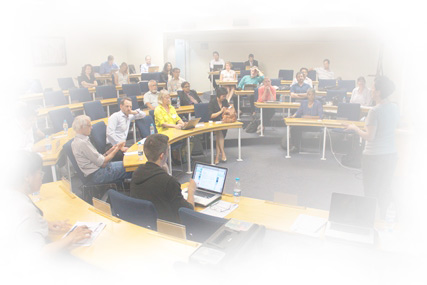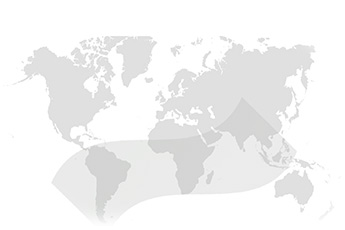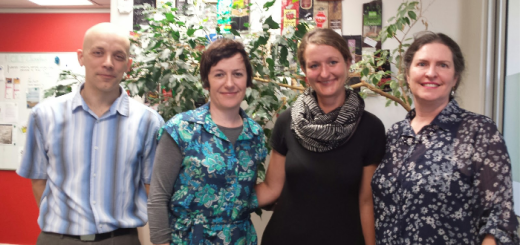By José Dutra de Oliveira Neto and Tess Cartmill – 6 November 2017
The use of OER “as is” (verbatim) is more prevalent in the Global South than OER creation or adaptation. This is revealed in data from a baseline survey undertaken of OER adoption by higher education instructors and students in nine countries in the Global South, as part of the Research on Open Educational Resources for Development (ROER4D) project, in which randomised surveys were administered in nine countries with 295 lecturers and 4784 students from 28 higher education institutes (HEIs) in South America, Sub-Saharan Africa, and South & Southeast Asia (see Appendix A, below, for the sample of countries and institutions from the Global South used in this study).
This blog explores the level of OER adoption – use, creation and adaptation – that higher education instructors and students in the Global South claim to have engaged in. It describes the data and technical processes undertaken in the data analysis to estimate the frequency of these open educational practices.
OER use by instructors
The use of OER (“as is”) by higher education instructors reported in our data (de Oliveira Neto, Pete, Daryono & Cartmill, 2017) indicates that 51% of them have used OER at least once, with the levels of use slightly differentiated by region: 56% in South and Southeast Asia, 50% in South America, and 46% in Sub-Saharan Africa (Figure 1). These responses were determined by a direct question that asked if instructors had ever used OER.
Figure 1: Use of OER by instructors (List of numbers and percentages in Appendix B).
OER use by students
The same question was also posed to students revealing that 39% have used OER at least once, with the regions differing quite substantially: 51% in South and Southeast Asia, 37% in South America, and 29% in Sub-Saharan Africa, with Indian students claiming the highest percentage of OER (85%) (Figure 2).
Figure 2: Use of OER by students (Appendix C)
Creation of OER by instructors
In the pilot studies of the survey instrument it became apparent that the concept of OER was not well understood by the research participants, so we used responses to a question about open licensing as a proxy for OER creation. This decision was based on the assumption that if educators had indicated they had applied an open license to any of their materials, they understood the concept of OER and had created OER. This yielded the results shown in Figure 3 where educators indicated that 23% had created OER at least once, with South and Southeast Asia the highest at 38%, then South America at 14% and Sub-Saharan Africa at 11%. Indonesian instructors created the most OER (56%) and Ghanaian instructors the least (5%).
Figure 3: Creation of OER by instructors (Appendix D)
Creation of OER by students
Using the same method as for instructors, the data show that overall only 9% of students have created OER at least once, with 14% in South and Southeast Asia, and 5% in the other two regions (Figure 4).
Figure 4: Creation of OER by students (Appendix E)
Adaptation of OER by instructors
To estimate the extent of OER adaptation (revising, remixing, translating OER), we compared the open licensing question with the general question about what activities (including “modifying”) instructors undertook in relation to a number types of “Educational Resources” (ER) (not OER specifically as this concept was not well enough understood to ask directly).
This approximation suggests that 18% of educators had adapted ER and attributed an open licence (30% in South & Southeast Asia, 12% in South America and 9% in Sub-Saharan Africa). As with creation of OER, the Indonesian educators seemed to be the most prolific adaptors of ER and users of open licences at 41% (Figure 5). An outlier in these findings is that no instructors in Brazil reported adapting ER, but this could be due to the relative small sample size in that particular country.
Figure 5: Adaptation of OER by instructors – approximation of adaptation of educational resources and open licensing (Appendix F)
Adaptation of OER by students
Using the same approximation as for instructors, the data suggest that very few students had adapted ER and attributed an open licence (6%), with South & Southeast Asia at 11%, South America at 4% and Sub-Saharan Africa at 3%, and Indonesia the highest at 16% (Figure 6).
Figure 6: Adaptation of OER by students – approximation of adaptation of educational resources and open licensing (Appendix G)
Concluding thoughts
It is not a surprise that educators would be using, creating and adapting OER more often than their students, but the comparatively low rates of OER creation and adaptation (versus OER use “as is”) by both groups suggest that the Global South is more of a consumer of OER than a producer of it. This is understandable in the short-term as educators and students get to know this relatively new pedagogical innovation, but over the long-term, it is through adapting and creating OER – through developing, altering, re-combining and sharing these open materials – that citizens of the Global South begin to experience the full value proposition of OER and start to reap the benefits from these higher order social inclusion activities than simply using OER “as is.”
The ROER4D project will be releasing an edited volume in December 2017 with the data and analyses from all of its various sub-projects, reflecting on these issues in much greater detail. Follow the ROER4D Blog or the Twitter account for further news on the edited volume.
Appendix A
Regions/ Countries and Higher Education Institutions that took part in the survey.
South America
- Brazil: Claretiano – Centro Universitário, Batatais, Universidade de São Paulo
- Chile: Universidad de Chile, Universidad Santo Tomás, Universidad de Tarapacá
- Colombia: Universidad Nacional de Colombia
Sub-Saharan Africa
- Kenya: Great Lakes University, Jomo Kenyatta University of Agriculture and Technology, Maseno University, Tangaza University College
- Ghana: Catholic Institute of Business and Technology, Kwame Nkrumah University of Science and Technology, University of Cape Coast, University of Ghana
- South Africa: University of Cape Town, University of Fort Hare, University of Pretoria, University of South Africa
South and Southeast Asia
- India: Gauhati University, University of Delhi
- Indonesia: Universitas Mercu Buana, Universitas Nasional, Universitas Pancasila, Universitas Terbuka
- Malaysia: Disted College, Kolej Damansara Utama, University of Malaya, Wawasan Open University
Appendix B
Use of OER by instructors (numbers):
| Region / Country | Yes, have used OER | Not sure if used OER | Never used OER | Grand Total |
| South America | 29 | 21 | 9 | 59 |
| Brazil | 12 | 4 | 1 | 17 |
| Chile | 15 | 12 | 6 | 33 |
| Colombia | 2 | 5 | 2 | 9 |
| Sub Saharan Africa | 53 | 36 | 26 | 115 |
| Ghana | 20 | 12 | 6 | 38 |
| Kenya | 21 | 13 | 9 | 43 |
| South Africa | 12 | 11 | 11 | 34 |
| S&SE Asia | 68 | 16 | 37 | 121 |
| India | 16 | 5 | 2 | 23 |
| Indonesia | 31 | 3 | 10 | 44 |
| Malaysia | 21 | 8 | 25 | 54 |
| Grand Total | 150 | 73 | 72 | 295 |
Use of OER by instructors (percentages):
| Region / Country | Yes, have used OER | Not sure if used OER | Never used OER | Grand Total |
| South America | 49,15% | 35,59% | 15,25% | 100,00% |
| Brazil | 70,59% | 23,53% | 5,88% | 100,00% |
| Chile | 45,45% | 36,36% | 18,18% | 100,00% |
| Colombia | 22,22% | 55,56% | 22,22% | 100,00% |
| Sub Saharan Africa | 46,09% | 31,30% | 22,61% | 100,00% |
| Ghana | 52,63% | 31,58% | 15,79% | 100,00% |
| Kenya | 48,84% | 30,23% | 20,93% | 100,00% |
| South Africa | 35,29% | 32,35% | 32,35% | 100,00% |
| S&SE Asia | 56,20% | 13,22% | 30,58% | 100,00% |
| India | 69,57% | 21,74% | 8,70% | 100,00% |
| Indonesia | 70,45% | 6,82% | 22,73% | 100,00% |
| Malaysia | 38,89% | 14,81% | 46,30% | 100,00% |
| Grand Total | 50,85% | 24,75% | 24,41% | 100,00% |
Appendix C
Use of OER by students (numbers):
| Region / Country | Yes, have used OER | Not sure if used OER | Never used OER | Grand Total |
| South America | 280 | 270 | 199 | 749 |
| Brazil | 109 | 94 | 83 | 286 |
| Chile | 102 | 99 | 92 | 293 |
| Colombia | 69 | 77 | 24 | 170 |
| Sub Saharan Africa | 652 | 928 | 657 | 2237 |
| Ghana | 180 | 368 | 269 | 817 |
| Kenya | 316 | 304 | 178 | 798 |
| South Africa | 156 | 256 | 210 | 622 |
| S&SE Asia | 923 | 477 | 398 | 1798 |
| India | 373 | 24 | 40 | 437 |
| Indonesia | 216 | 274 | 155 | 645 |
| Malaysia | 334 | 179 | 203 | 716 |
| Grand Total | 1855 | 1675 | 1254 | 4784 |
Use of OER by students (percentages):
| Region / Country | Yes, have used OER | Not sure if used OER | Never used OER | Grand Total |
| South America | 37,38% | 36,05% | 26,57% | 100,00% |
| Brazil | 38,11% | 32,87% | 29,02% | 100,00% |
| Chile | 34,81% | 33,79% | 31,40% | 100,00% |
| Colombia | 40,59% | 45,29% | 14,12% | 100,00% |
| Sub Saharan Africa | 29,15% | 41,48% | 29,37% | 100,00% |
| Ghana | 22,03% | 45,04% | 32,93% | 100,00% |
| Kenya | 39,60% | 38,10% | 22,31% | 100,00% |
| South Africa | 25,08% | 41,16% | 33,76% | 100,00% |
| S&SE Asia | 51,33% | 26,53% | 22,14% | 100,00% |
| India | 85,35% | 5,49% | 9,15% | 100,00% |
| Indonesia | 33,49% | 42,48% | 24,03% | 100,00% |
| Malaysia | 46,65% | 25,00% | 28,35% | 100,00% |
| Grand Total | 38,78% | 35,01% | 26,21% | 100,00% |
Appendix D
Creation of OER by instructors (numbers):
| Region / Country | Created OER | Not created OER | Grand Total |
| South America | 8 | 51 | 59 |
| Brazil | 1 | 16 | 17 |
| Chile | 5 | 28 | 33 |
| Colombia | 2 | 7 | 9 |
| Sub Saharan Africa | 13 | 102 | 115 |
| Ghana | 2 | 36 | 38 |
| Kenya | 5 | 38 | 43 |
| South Africa | 6 | 28 | 34 |
| S&SE Asia | 46 | 75 | 121 |
| India | 9 | 14 | 23 |
| Indonesia | 24 | 20 | 44 |
| Malaysia | 13 | 41 | 54 |
| Grand Total | 67 | 228 | 295 |
Creation of OER by instructors (percentages):
| Region / Country | Created OER | Not created OER | Grand Total |
| South America | 13,56% | 86,44% | 100,00% |
| Brazil | 5,88% | 94,12% | 100,00% |
| Chile | 15,15% | 84,85% | 100,00% |
| Colombia | 22,22% | 77,78% | 100,00% |
| Sub Saharan Africa | 11,30% | 88,70% | 100,00% |
| Ghana | 5,26% | 94,74% | 100,00% |
| Kenya | 11,63% | 88,37% | 100,00% |
| South Africa | 17,65% | 82,35% | 100,00% |
| S&SE Asia | 38,02% | 61,98% | 100,00% |
| India | 39,13% | 60,87% | 100,00% |
| Indonesia | 54,55% | 45,45% | 100,00% |
| Malaysia | 24,07% | 75,93% | 100,00% |
| Grand Total | 22,71% | 77,29% | 100,00% |
Appendix E
Creation of OER by students (numbers):
| Region / Country | Created OER | Not created OER | Grand Total |
| South America | 41 | 708 | 749 |
| Brazil | 18 | 268 | 286 |
| Chile | 11 | 282 | 293 |
| Colombia | 12 | 158 | 170 |
| Sub Saharan Africa | 120 | 2117 | 2237 |
| Ghana | 30 | 787 | 817 |
| Kenya | 47 | 751 | 798 |
| South Africa | 43 | 579 | 622 |
| S&SE Asia | 252 | 1546 | 1798 |
| India | 36 | 401 | 437 |
| Indonesia | 109 | 536 | 645 |
| Malaysia | 107 | 609 | 716 |
| Grand Total | 413 | 4371 | 4784 |
Creation of OER by students (percentages):
| Region / Country | Created OER | Not created OER | Grand Total |
| South America | 5,47% | 94,53% | 100,00% |
| Brazil | 6,29% | 93,71% | 100,00% |
| Chile | 3,75% | 96,25% | 100,00% |
| Colombia | 7,06% | 92,94% | 100,00% |
| Sub Saharan Africa | 5,36% | 94,64% | 100,00% |
| Ghana | 3,67% | 96,33% | 100,00% |
| Kenya | 5,89% | 94,11% | 100,00% |
| South Africa | 6,91% | 93,09% | 100,00% |
| S&SE Asia | 14,02% | 85,98% | 100,00% |
| India | 8,24% | 91,76% | 100,00% |
| Indonesia | 16,90% | 83,10% | 100,00% |
| Malaysia | 14,94% | 85,06% | 100,00% |
| Grand Total | 8,63% | 91,37% | 100,00% |
Appendix F
Adaptation of OER by instructors (numbers):
| Region / Country | Modified OER | Not Modified OER | Grand Total |
| South America | 7 | 52 | 59 |
| Brazil | 17 | 17 | |
| Chile | 5 | 28 | 33 |
| Colombia | 2 | 7 | 9 |
| Sub Saharan Africa | 10 | 105 | 115 |
| Ghana | 2 | 36 | 38 |
| Kenya | 3 | 40 | 43 |
| South Africa | 5 | 29 | 34 |
| S&SE Asia | 36 | 85 | 121 |
| India | 7 | 16 | 23 |
| Indonesia | 18 | 26 | 44 |
| Malaysia | 11 | 43 | 54 |
| Grand Total | 53 | 242 | 295 |
Adaptation of OER by instructors (percentages):
| Region / Country | Modified OER | Not Modified OER | Grand Total |
| South America | 11,86% | 88,14% | 100,00% |
| Brazil | 0,00% | 100,00% | 100,00% |
| Chile | 15,15% | 84,85% | 100,00% |
| Colombia | 22,22% | 77,78% | 100,00% |
| Sub Saharan Africa | 8,70% | 91,30% | 100,00% |
| Ghana | 5,26% | 94,74% | 100,00% |
| Kenya | 6,98% | 93,02% | 100,00% |
| South Africa | 14,71% | 85,29% | 100,00% |
| S&SE Asia | 29,75% | 70,25% | 100,00% |
| India | 30,43% | 69,57% | 100,00% |
| Indonesia | 40,91% | 59,09% | 100,00% |
| Malaysia | 20,37% | 79,63% | 100,00% |
| Grand Total | 17,97% | 82,03% | 100,00% |
Appendix G
Adaptation of OER by students (numbers):
| Region / Country | Modified OER | Not modified OER | Grand Total |
| South America | 32 | 717 | 749 |
| Brazil | 12 | 274 | 286 |
| Chile | 8 | 285 | 293 |
| Colombia | 12 | 158 | 170 |
| Sub Saharan Africa | 57 | 2180 | 2237 |
| Ghana | 11 | 806 | 817 |
| Kenya | 17 | 781 | 798 |
| South Africa | 29 | 593 | 622 |
| S&SE Asia | 189 | 1609 | 1798 |
| India | 27 | 410 | 437 |
| Indonesia | 100 | 545 | 645 |
| Malaysia | 62 | 654 | 716 |
| Grand Total | 278 | 4506 | 4784 |
Adaptation of OER by students (percentages):
| Region / Country | Modified OER | Not modified OER | Grand Total |
| South America | 4,27% | 95,73% | 100,00% |
| Brazil | 4,20% | 95,80% | 100,00% |
| Chile | 2,73% | 97,27% | 100,00% |
| Colombia | 7,06% | 92,94% | 100,00% |
| Sub Saharan Africa | 2,55% | 97,45% | 100,00% |
| Ghana | 1,35% | 98,65% | 100,00% |
| Kenya | 2,13% | 97,87% | 100,00% |
| South Africa | 4,66% | 95,34% | 100,00% |
| S&SE Asia | 10,51% | 89,49% | 100,00% |
| India | 6,18% | 93,82% | 100,00% |
| Indonesia | 15,50% | 84,50% | 100,00% |
| Malaysia | 8,66% | 91,34% | 100,00% |
| Grand Total | 5,81% | 94,19% | 100,00% |
References
de Oliveira Neto, J. D., Pete, J., Daryono & Cartmill, T. (2017). OER use in the Global South: A baseline survey of higher education instructors. In C. Hodgkinson-Williams & P. B. Arinto (Eds.), Adoption and impact of OER in the Global South. Chapter 3 advance publication. Retrieved from











